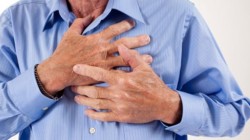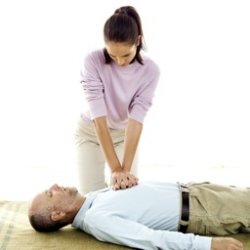Author:
|
Back to Blog
Like us on facebook could pay off3/31/2014 If your not one of our Facebook followers this is a great way for you and your friends to get in on this all that you have to do is like us on Facebook or have one of your friends like CPR Northwest on Facebook from now to April 16th and you will be in the drawing for a $50.00 Macy's gift card. If you have one of your friends like us make sure that they put your name on our wall for your to be in the drawing. And good luck to all of you. (503) 538-2610
0 Comments
Read More
Back to Blog
March 25th, 20143/25/2014  Researchers in Sweden and the United Kingdom analyzed data from 120,000 Swedish patients and 400,000 UK patients who had heart attacks between 2004 and 2010. According to the study published in the Lancet, patients in the UK had an increased risk of death, which may have resulted in 11,263 more deaths (in contrast to Sweden) over the course of the study. Turns out, Percutaneous Coronary Intervention (stent) was utilized at least twice as more in Sweden, and Sweden also used beta-blockers for more patients. So, although these two nations have similar medical technologies, under-utilizing such advances have contributed to large differences in the management and outcomes of patients. Back in the U.S., Mayo Clinic researchers have found that short term mortality was 6% higher when heart attack patients arrived at the ER during off hours. Patients with large STEMI heart attacks were 60% less likely to undergo stent intervention if they arrived during off hours. The data can be traced to the fact that cardiologists and cardiac catheterization laboratory staff may not be available at certain times. This can be unsettling for many, since it points out that patients suffering heart attacks at night or on a weekend will not have equal access to life-sustaining technologies. To take a CPR class give us a call at 503-538-2610 or like on facebook for all kinds of information.
Back to Blog
Sudden Cardiac Arrest3/23/2014 The bad news:
The Truth About Sudden Cardiac Arrest It’s widespread. Each year, Emergency Medical Services treats nearly 300,000 victims of out‐of‐hospital cardiac arrest. It’s unexpected. It can happen to anyone at any time. Many victims seem healthy with no known heart disease or other risk factors. It’s urgent. Unless CPR and defibrillation are provided within minutes of collapse, few attempts at resuscitation are successful. It’s deadly. More than 92 percent of people who suffer cardiac arrest outside the hospital will die from it. It’s undertreated. Less than one‐third of out‐of‐hospital sudden cardiac arrest victims receive bystander CPR. The good news: It’s NOT hopeless. Effective bystander CPR, provided immediately after sudden cardiac arrest, can double or triple a victim’s chance of survival If you need to take a class you can give us a call at (503) 538-2610
Back to Blog
Heart Attack Symptoms in Women3/18/2014  We’ve all seen the movie scenes where a man gasps, clutches his chest and falls to the ground. In reality, a heart attack victim could easily be a woman, and the scene may not be that dramatic. “Although men and women can experience chest pressure that feels like an elephant sitting across the chest, women can experience a heart attack without chest pressure, ” said Nieca Goldberg, M.D., medical director for the Joan H. Tisch Center for Women's Health at NYU’s Langone Medical Center and an American Heart Association volunteer. “Instead they may experience shortness of breath, pressure or pain in the lower chest or upper abdomen, dizziness, lightheadedness or fainting, upper back pressure or extreme fatigue.” Even when the signs are subtle, the consequences can be deadly, especially if the victim doesn’t get help right away. ‘I thought I had the flu’ Even though heart disease is the No. 1 killer of women, women often chalk up the symptoms to less life-threatening conditions like acid reflux, the flu or normal aging. “They do this because they are scared and because they put their families first,” Goldberg said. “There are still many women who are shocked that they could be having a heart attack.” A heart attack strikes someone about every 34 seconds. It occurs when the blood flow that brings oxygen to the heart muscle is severely reduced or cut off completely. This happens because the arteries that supply the heart with blood can slowly become thicker and harder from a buildup of fat, cholesterol and other substances (plaque). Watch an animation of a heart attack. Many women think the signs of a heart attack are unmistakable — the image of the elephant comes to mind — but in fact they can be subtler and sometimes confusing. You could feel so short of breath, “as though you ran a marathon, but you haven't made a move,” Goldberg said. Some women experiencing a heart attack describe upper back pressure that feels like squeezing or a rope being tied around them, Goldberg said. Dizziness, lightheadedness or actually fainting are other symptoms to look for. “Many women I see take an aspirin if they think they are having a heart attack and never call 9-1-1,” Goldberg said. “But if they think about taking an aspirin for their heart attack, they should also call 9-1-1.” Take care of yourself Heart disease is preventable. Here are Goldberg’s top tips:
To take a class give us a call at (503_
Back to Blog
How to perform chest compressions3/15/2014  Chest compressions are the most important component of cardiopulmonary resuscitation (CPR). It is vital chest compressions are of good quality if CPR is going to be effective in keeping the casualty alive until the arrival of a defibrillator (AED). In order to perform high quality chest compressions you should:
To deliver effective chest compressions you should be using the whole weight of your upper body, just using your arm muscles alone is unlikely to deliver enough force. If you would like to take a CPR class or it has been years between your last CPR class give us a call we make taking CPR fun and easy. (503) 538-2610 or
Back to Blog
 The National Institute for Occupational Safety and Health (NIOSH) has recently published some interesting survey results about healthcare workers and their interaction with hazardous chemicals. According to their article in the American Journal of Industrial Medicine, “healthcare workers who routinely come in contact with hazardous chemicals on the job lack training and awareness of employer procedures to adequately protect themselves from exposure.” The 2011 survey had over 12,000 participants, all of whom were healthcare workers who routinely come in contact with hazardous chemicals. The researchers wanted to get a handle on issues such as training, best practices to minimize exposure, and the use of personal protective equipment (PPE). Chemical agents of concern were antineoplastic agents, high level disinfectants, aerosolized medications, anesthetic gases, surgical smoke and chemical sterilants. “Study findings include:
Whether you are in the healthcare field or a different business sector, if you have hazardous chemicals in your workplace, you’ll need to know about OSHA’s Global Harmonized System (GHS), the new system for labeling and classifying chemicals. New safety data sheets and training are required to keep businesses in compliance. The first training deadline was December 1, 2013. You can read more about GHS on our blog and learn how Summit Training Source can help you with training on this new system.
Back to Blog
Like us on facebook3/10/2014 Hello to all of my Facebook followers this is a great way for you and your friends to get in on this all that you have to do is like us on Facebook or have one of your friends like CPR Northwest on Facebook from now to April 16th and you will be in the drawing for a $50.00 Macy's gift card. If you have one of your friends like us make sure that they put your name on our wall for your to be in the drawing. And good luck to all of you. (503) 538-2610
Back to Blog
Common Tests for Heart Failure3/8/2014 To determine whether you have heart failure, your healthcare team may do some or all of these diagnostic tests and procedures.
Common tests for heart failure Physical examination How it's done:
Back to Blog
 Men & Women heart attacks can be different. Know what to look for? Take 10 minutes here and find out. You may save someone’s or your own life as a result. Some heart attacks are sudden and intense where no one doubts what’s happening. But most heart attacks start slowly, with mild pain or discomfort. Often people affected aren’t sure what’s wrong and wait too long before getting help. Here are signs that can mean a heart attack is happening:
Even when the signs are subtle, the consequences can be deadly, especially if the victim doesn’t get help right away. “I thought I had the flu” Even though heart disease is the No. 1 killer of women, women often chalk up the symptoms to less life-threatening conditions like acid reflux, the flu or normal aging. Nieca Goldberg, M.D., medical director for the Joan H. Tisch Center for Women’s Health at NYU’s Langone Medical Center states: “They do this because they are scared and because they put their families first. There are still many women who are shocked that they could be having a heart attack.” If you have any of these signs, don’t wait more than five minutes before calling for help. Call 9-1-1 and get to a hospital right away. I’ve given a link at the bottom of this page for more “Warning Signs of a Heart Attack” information. To take a CPR or First aid class give us a call
Back to Blog
Why Quit Smoking3/2/2014 Smoking is the most important preventable cause of premature death in the United States. Smokers have a higher risk of developing many chronic disorders, including atherosclerosis — the buildup of fatty substances in the arteries — which can lead to coronary heart disease, heart attack (myocardial infarction) and stroke. Controlling or reversing atherosclerosis is an important part of preventing future heart attack or stroke.
Dr. Clyde Yancy explains the health risks of smoking You can modify or control six major independent risk factors for coronary heart disease:
When it acts with the other factors, it greatly increases your risk from those factors, too. Smoking decreases your tolerance for physical activity and increases the tendency for blood to clot. It decreases HDL (good) cholesterol. Your risks increase greatly if you smoke and have a family history of heart disease. Smoking also creates a higher risk for peripheral artery disease and aortic aneurysm. It increases the risk of recurrent coronary heart disease after bypass surgery, too. Medical reporter John Hammarley discusses avoiding weight gain Smoking is also an important risk factor for stroke. Inhaling cigarette smoke produces several effects that damage the cerebrovascular system. Women who take oral contraceptives and smoke increase their risk of stroke many times.Cigars and pipes aren't a "safer" alternative to cigarettes. People who smoke cigars or pipes seem to have a higher risk of death from coronary heart disease (and possibly stroke), even though their risk isn't as great as that of cigarette smokers. Breathe clean air It's also important to avoid other people's smoke. The link between secondhand smoke (also called environmental tobacco smoke) and disease is well known, and the connection to cardiovascular-related disability and death is also clear. Each year about 38,000 people die from heart and blood vessel disease caused by other people's smoke. Nonsmokers who are exposed to secondhand smoke at home or at work increase their risk of developing heart disease by 25–30 percent. Let healing begin today If you already have heart disease, you may think, "What good will it do me to quit smoking now?" But don't be discouraged. Your lungs can begin to heal themselves as soon as you stop harming them with more smoke. Heart disease can be prevented and controlled, but you must follow your treatment plan — and quitting smoking is a big part. |

 RSS Feed
RSS Feed